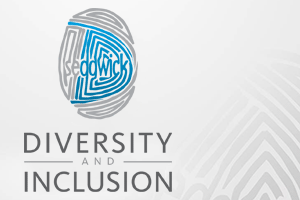
At Sedgwick, we see the value of diversity and inclusion every day in many of our common business practices. Putting these concepts into action enhances our customer service capabilities, expands our business strategies, attracts a wider pool of qualified job candidates, and positions us to identify the next generation of leadership.
Today’s workforce is becoming increasingly diverse and includes individuals from four separate generations and various racial and ethnic backgrounds, as well as those with other defining characteristics and experiences. By acknowledging and understanding these differences, we can better recognize the unique, defining traits that make our customers who they are and facilitate the best possible outcomes for their injured workers. This is program customization at its most meaningful.
To accomplish these objectives, we must be willing to explore new sources of industry talent and develop policies and practices that consider how different backgrounds and experiences bring value to our core business. A good starting point is engaging and listening to the diverse talent within our own organization already.
Responding to our clients
The Spanish-speaking population recently became the majority in the state of California. It stands to reason that our client populations mirror this trend. Significantly, Hispanics suffer a proportionately higher incidence of severe industrial injuries. The combination of accident severity and ineffective communication creates the perfect storm that leads to a long and costly claim experience. Integrating cultural competency into claims management best practices is not only the right thing to do; it’s an industry necessity.
Increasingly, customers require bilingual claims examiners, and we at Sedgwick have redoubled our efforts to incorporate bilingual talent into our claim units. Currently more than 20 percent of our examiners in California are bilingual. Our ability to communicate in a native language is a critical tool for gaining the trust of injured employees for whom English is a second language. Additionally, it is just as important that we understand how differences in culture and values affect perceptions and play a vital role in claim resolution. Removing language-related and cultural barriers reduces friction in the system.
Drawing on their skills, our bilingual colleagues have helped us improve our client service. Working with our internal development team at Sedgwick University, we produced “cheat sheets” to help colleagues who are not bilingual translate technical terms into Spanish. We are also working to introduce our bilingual capability to our clients’ employee populations early in the process–before claims are filed–so those for whom English is a second language are reassured that, should they experience an injury, they have advocates on their side and alternatives to litigation.
Growing a diverse team
The availability and retention of talent is a continuing challenge for the claims industry. To meet this challenge, support growth, and provide our customers with continuity of service, Sedgwick offers training and development through our Industry Advancement Program (IAP). The program provides accelerated training for college graduates and qualified internal colleagues to prepare them for careers as claim representatives at Sedgwick. The IAP, just one of the many educational programs developed by Sedgwick University, is conducted in three phases over a four-month period. It starts with orientation, job shadowing opportunities, webinars and self-paced learning, followed by two or three weeks of "Claims College" at one of Sedgwick’s educational centers in California. During the final phase, trainees continue learning through a combination of assignments and handling caseloads under the guidance of experienced mentors and supervisors. This course of study aims to introduce graduates to the breadth of opportunities available to them. The intensive training allows new professionals to begin their careers with a firm foundation, which, in turn, helps them build long-term careers in the industry.
As one might expect, these programs serve to introduce the industry to a new generation of claims professionals, many of whom are millennials. Understanding the needs of this population has led us to modify our programs to reflect career development opportunities more in line with their expectations. From our experience, these individuals are looking for employment that is not only opportunity-rich, but also meaningful in purpose. The early integration of cultural competency and diversity and inclusion strategies into our curriculum is particularly appealing to millennials and an important building block in their development.
Most importantly, the IAP encourages us to explore new and different sources of talent that reflect the rich diversity in our communities. These talent pools may include ethnic diversity, along with various other attributes and life experiences. Military veterans, for example, offer excellent employment skills and characteristics that match up well within our job requirements.
Developing leaders
In addition to developing sources for emerging talent, the need to identify future leaders is critical to the success of our company and our industry. Effective succession planning shares many common objectives with the core values of diversity and inclusion. By definition, the process is inclusive: inviting colleagues with new ideas, innovative perspectives and diverse experiences to drive the growth and vitality of our company. It also helps our leaders empower others through delegation. Entrusting responsibility to others is critical to our colleagues’ growth as individuals and to our collective organizational growth now and in the future.
Business reputations flourish when companies demonstrate their commitment to diversity through inclusive internal practices reflecting a “care of people” philosophy and aggressively recruiting a wide range of talent externally. Additionally, customer satisfaction improves because barriers to effective communication are removed. The real payoff is an increased level of loyalty and commitment from colleagues who develop a sense of pride in being a part of the organization that values their individuality.
Jay Ayala
Managing Director
Sedgwick